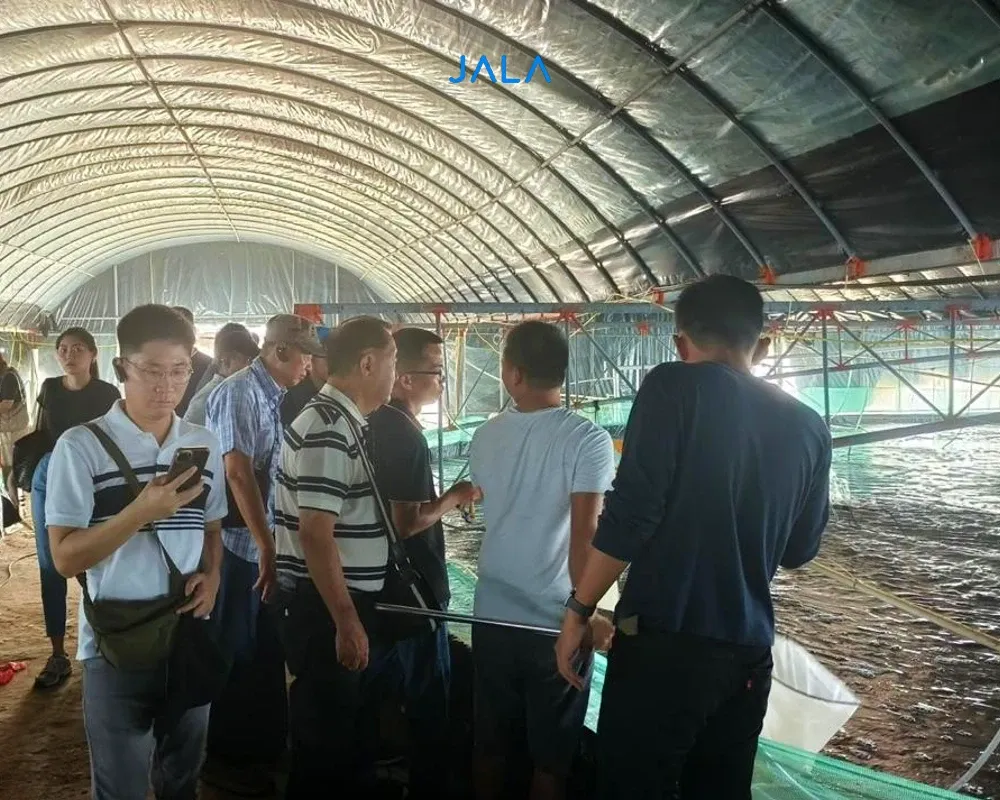
China stands as a formidable player in the global shrimp industry, boasting not only high productivity but also an impressive local market size of almost 3 million tons annually. Intrigued by how China managed to achieve such feats, Aryo Wiryawan, a shrimp industry player who is also the Chairman of JALA, had the opportunity to visit China and took some key learning points which can be implemented in Indonesia.
Impressed with the Integrated Research and Technology in China’s Shrimp Farms
Aryo’s first agenda during his visit was visiting some shrimp farms. These farms cultivate in indoor space with advanced technologies. Wastewater is processed with Recirculating Aquaculture Systems (RAS) or partial recirculation technology, ensuring minimal environmental impact and promoting the sustainable use of resources. This recirculated water is reused to cultivate shrimp with advanced innovations.

Not only that, these farms’ success is also attributed to the stocking of carefully selected shrimp fry with genetics suited for their living environment. Throughout the cultivation, shrimp are subjected to feeding programs carefully designed to reach optimal growth. This level of precision and care is made possible through the support of experts, many holding advanced degrees, who are dedicated to supporting the shrimp farming industry.
This trend of indoor shrimp farming has been the splash in China’s cultivation for the last 5-6 years, while recirculation efforts are done to comply with the government’s strict regulations regarding waste disposal. However, this advanced cultivation operation drives another question to mind: how does China cope with the consequent rising production costs? The answer, it turns out, lies in their exceptional distribution and remarkable local consumption.
Consumers’ Appetite for Live Shrimp
Most of China’s shrimp farms harvest their shrimp alive and keep them in living conditions throughout post-harvest. Trucks with a capacity of 3.5 tons carry the shrimp at a temperature of 15°C, ready to take them on a journey of over 20 hours. Supported by China’s robust infrastructure, the live shrimp can reach various regions of China in prime condition until they are sold to consumers.
A High Local Demand for Shrimp, Driven by Culture
The appetite for seafood among China’s population is more than just a trend, it’s deeply embedded in their national holidays as well as cultural and religious celebrations. During Chinese New Year, as an example, the price for shrimp could experience a staggering twofold increase from its average price, and customers would still buy it without hesitation. The diversity of local menus that incorporate shrimp as their ingredient, backed by the consistent supply of shrimp, allows local consumption to soar.
Essential Takeaways as a Hope for Indonesia to be the Top Shrimp Producer Globally
In some ways, it’s true that Indonesia can’t mimic everything China is doing for their success. For a start, Indonesia’s local demand for shrimp is relatively lower compared to fish as shrimp is still considered an expensive source of protein for most households.
Comprehensive research is needed from broodstock, shrimp fry, and quality feed, followed by productive and efficient cultivation technology, to market analysis. For instance, fry genetics should be developed to suit local needs, such as having the ability to withstand current water conditions in the area or disease resistance, which will then influence feed requirements and other aspects of cultivation. Some of the hatcheries in Indonesia have already begun efforts in this direction, and these initiatives should be continued and expanded.
From a farming perspective, adopting environmentally friendly technologies, particularly in waste management, is crucial. Improving distribution and logistics systems is equally important, as both quality and availability are key factors that can boost local consumption.
Reflecting back on China’s efficient and well-integrated shrimp distribution system, Indonesia can take many important lessons. Still, this is an important inspiration, underscoring the need for adequate transportation infrastructure and advanced harvest distribution methods to ensure a consistent supply for future demands.
While a national campaign to promote shrimp consumption could help, JALA is also dedicated to educating the importance of shrimp nutrition for future generations. The goal is that, eventually, shrimp consumption is no longer a luxury, but a culture and lifestyle deeply rooted in our diverse ethnicities, even as important as beef or chicken in our local cuisine.
Strengthening the Shrimp Industry by Optimizing Cultivation Practices and Shrimp Quality
JALA is committed to strengthening Indonesia’s shrimp industry, starting by providing adequate cultivation logistics, efficient farming practices, and distributing shrimp to consumers to ensure high-quality shrimp for both domestic and export markets. Our aim is to create a more seamless distribution chain while prioritizing shrimp quality. With better quality, the local demand for shrimp will increase, thus empowering shrimp farmers without over-dependence on export markets.
Finally, Aryo and JALA invite all shrimp industry players to keep driving innovation and initiatives for a productive, sustainable, and strong domestic market in Indonesia's shrimp industry.





